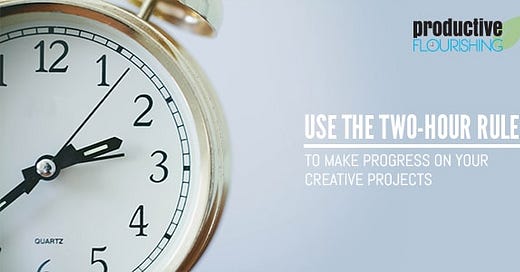Use the Two-Hour Rule to Make Progress on Your Creative Projects
Two hour is long enough to make progress, but not so long that it gets away from you
Are you having trouble getting started with a creative project or figuring out how to keep momentum with it? Try using the two-hour rule.
One of the reasons people get stuck with creative projects is that they make a conscious or unconscious plan to spend a full day or week working on something. Reality check: most of us will never get full days to work on something, and when we do, we can't work for that long anyway. Our creative energy won't last that long.
The flip side of the coin is that most creative, daring projects are hard to do in 15- and 30-minute chunks. Most projects like this have an engagement threshold that requires that you have enough time to set up and sink into the Flow. Since it's frustrating to not finish and hard for most people to pick up where they left off, the natural response is that we don't start. Better to vacuum, check email, or stay up to date with the YouTube meme of the day. (Because such things matter.)
Lastly, it's often very hard to tell how much to chunk your projects down into smaller pieces, when you do think about chunking them down.
Enter the Two-Hour Rule: chunk your creative work down into two-hour increments. (Click to tweet.)
Two hours is long enough that you can make significant progress, but not so long that it becomes a Thing to manage.
Here are a few reasons why the Two-Hour Rule works:
It tracks the reality of our creative energy and circadian rhythms. Though each of us has slightly different patterns, most of us go through a creative/circadian cycle about every two hours. Peak-performing creatives in ideal environments can normally sustain that energy for only 4--6 hours - most of us just can't maintain that level of focus and get diminishing returns after 2 hours.
Most people can step away for two hours without things burning down. A counterproductive belief that many creatives have is that they need to be plugged into what's going on at all times. Granted, they don't tell themselves that overtly, but their actions say otherwise. If you can't carve two hours out of your day somewhere, it's a sign of other, more pressing issues than your creative work (over-commitment, co-dependency, poor expectation management, etc.). (This post is written from the perspective of creative knowledge-workers who have some autonomy over their time but choose to fritter it away. If you work in an organization that has poor communication practices and even worse expectations, then you may not be able to keep your job and step away during your workday. Similarly, if you have a customer service job or another primarily reactive job, you may find it harder to firewall your time; to be reactive well is to be productive in that context.)
It's surprisingly simple to find two hours in your day to repurpose for the things that matter most. Trim a TV show or two. Get up a little earlier. Get your kids to bed earlier. Rather than batching chores and household work, spread them out over the week in the evenings when you're tired and can't do anything creative anyway; then use the afternoons you would've been doing chores to work on your project. Eliminate a social activity that's not serving anyone. As Gandhi said, "Action expresses priority." If it matters to you, you'll find a way.
Most of us know about how much we can get done in two hours. Compare "how many words can you write in two hours?" to "how many words can you write in a day?" Substitute your creative thing for "write" and you get my point.
It helps us think in the more native blocks of time rather than in artificial hours. This one's subtle but still important. Hours are a relatively recent way of slicing human existence, whereas part of the complex of features that make up self-awareness is the recognition of blocks of time. The fact that we have psychochemical rhythms (mentioned above) gives us an unconscious unit of experience. But there's more to it than that: it simplifies both our daily planning and our project planning. Once you get it, it's easier to say "that'll take me four creative blocks" rather than "that'll take me eight hours" precisely because you know what you can do in a creative block (two hours).
The next time you're thinking about getting started on a project or wondering how to chunk it down, use the Two-Hour Rule to make it more approachable. Sneaky tip: sometimes you have to give yourself two hours of time, at the same time that you tell yourself that you have to do only 10 minutes of whatever needs to be done. More often than not, you'll create for two hours if you give yourself the boundaries on both sides.
The Two-Hour Rule works well unless, of course, you're shuffling or lying. Watch out for those two as well.
Oh, and one last thing. Our planners have this line of thinking already baked in. Happy planning and project-completing.





